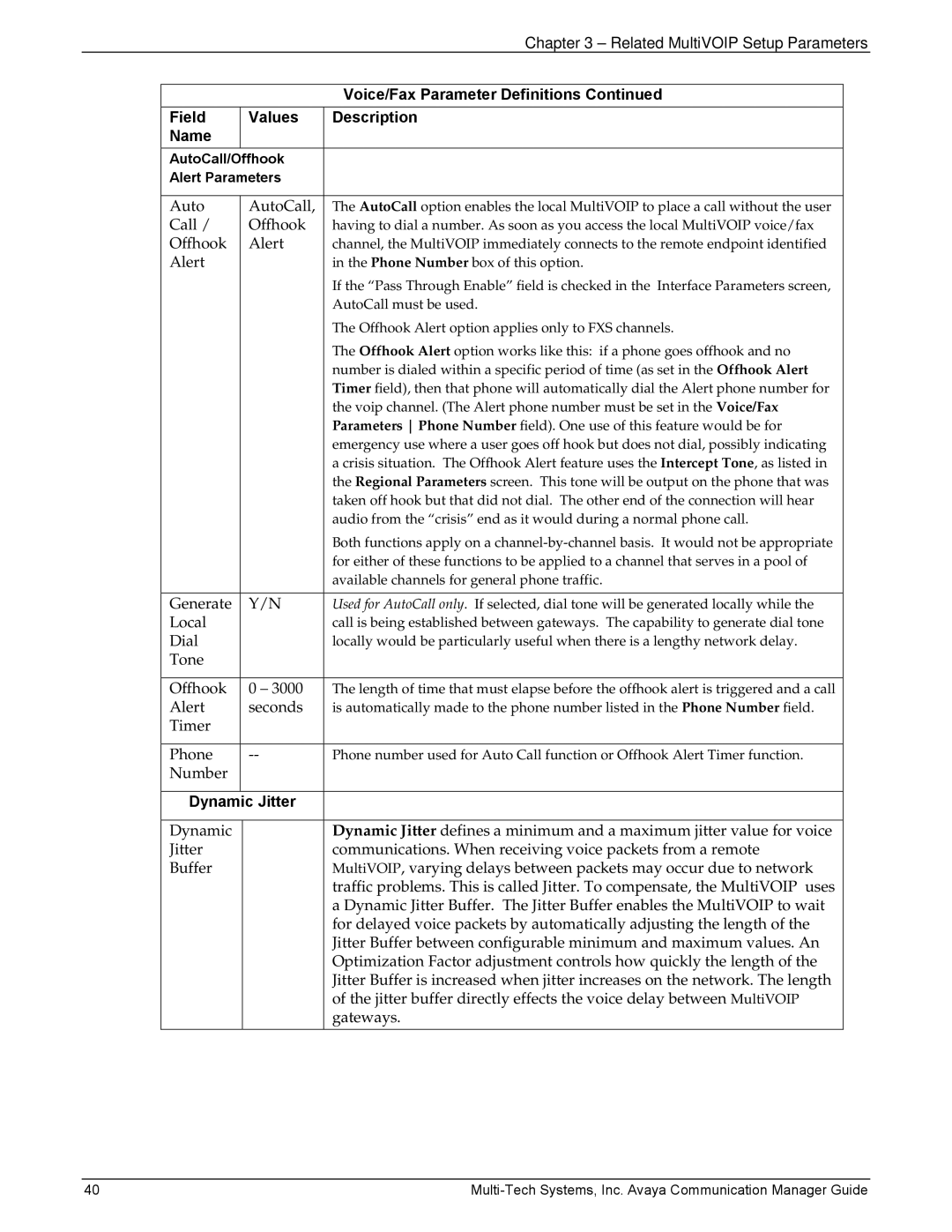
Chapter 3 – Related MultiVOIP Setup Parameters
|
| Voice/Fax Parameter Definitions Continued |
Field | Values | Description |
Name |
|
|
AutoCall/Offhook |
| |
Alert Parameters |
| |
|
|
|
Auto | AutoCall, | The AutoCall option enables the local MultiVOIP to place a call without the user |
Call / | Offhook | having to dial a number. As soon as you access the local MultiVOIP voice/fax |
Offhook | Alert | channel, the MultiVOIP immediately connects to the remote endpoint identified |
Alert |
| in the Phone Number box of this option. |
|
| If the “Pass Through Enable” field is checked in the Interface Parameters screen, |
|
| AutoCall must be used. |
|
| The Offhook Alert option applies only to FXS channels. |
|
| The Offhook Alert option works like this: if a phone goes offhook and no |
|
| number is dialed within a specific period of time (as set in the Offhook Alert |
|
| Timer field), then that phone will automatically dial the Alert phone number for |
|
| the voip channel. (The Alert phone number must be set in the Voice/Fax |
|
| Parameters Phone Number field). One use of this feature would be for |
|
| emergency use where a user goes off hook but does not dial, possibly indicating |
|
| a crisis situation. The Offhook Alert feature uses the Intercept Tone, as listed in |
|
| the Regional Parameters screen. This tone will be output on the phone that was |
|
| taken off hook but that did not dial. The other end of the connection will hear |
|
| audio from the “crisis” end as it would during a normal phone call. |
|
| Both functions apply on a |
|
| for either of these functions to be applied to a channel that serves in a pool of |
|
| available channels for general phone traffic. |
|
|
|
Generate | Y/N | Used for AutoCall only. If selected, dial tone will be generated locally while the |
Local |
| call is being established between gateways. The capability to generate dial tone |
Dial |
| locally would be particularly useful when there is a lengthy network delay. |
Tone |
|
|
|
|
|
Offhook | 0 – 3000 | The length of time that must elapse before the offhook alert is triggered and a call |
Alert | seconds | is automatically made to the phone number listed in the Phone Number field. |
Timer |
|
|
|
|
|
Phone | Phone number used for Auto Call function or Offhook Alert Timer function. | |
Number |
|
|
|
|
|
Dynamic | Jitter |
|
|
|
|
Dynamic |
| Dynamic Jitter defines a minimum and a maximum jitter value for voice |
Jitter |
| communications. When receiving voice packets from a remote |
Buffer |
| MultiVOIP, varying delays between packets may occur due to network |
|
| traffic problems. This is called Jitter. To compensate, the MultiVOIP uses |
|
| a Dynamic Jitter Buffer. The Jitter Buffer enables the MultiVOIP to wait |
|
| for delayed voice packets by automatically adjusting the length of the |
|
| Jitter Buffer between configurable minimum and maximum values. An |
|
| Optimization Factor adjustment controls how quickly the length of the |
|
| Jitter Buffer is increased when jitter increases on the network. The length |
|
| of the jitter buffer directly effects the voice delay between MultiVOIP |
|
| gateways. |
|
|
|
40 |
